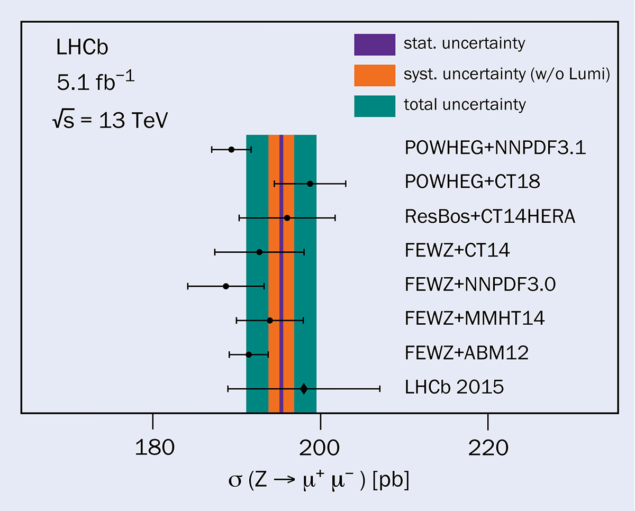A report from the LHCb experiment.

The precise determination of the Z-boson parameters at e+e– colliders was crucial for the establishment of the electroweak theory of the Standard Model. Today, the Z boson has become an essential object of experimental study at the LHC. In particular, measurements of the Z boson’s production and decay properties in high-energy proton–proton collisions provide insights into the parton distribution functions (PDFs) of the proton and are an implicit test of quantum chromodynamics (QCD).
Recently, using a sample of Z → μ+μ– events, the LHCb collaboration reported the most precise measurement to date of the Z-boson production cross section in the forward region at a centre-of-mass energy of 13 TeV (see figure 1). The collaboration also reported the first measurements of the angular coefficients in Z → μ+μ– decays in the forward region, which encode key information about the QCD mechanisms underlying the Z-boson production mechanism. In addition to improving knowledge of the proton PDFs, these two analyses contribute to the study of spin-momentum correlations in the proton, complementing ATLAS and CMS measurements in the central region.
In addition to the up and down valence quarks, a proton comprises a sea of quark–antiquark pairs primarily produced via gluon splitting. Given their similar masses, one would expect that the nucleon sea is flavour-symmetric for up and down quarks. However, in the early 1990s, the New Muon Collaboration at CERN found that this symmetry is violated. Later, the ratio of down antiquarks to up antiquarks in the proton was directly measured by the NA51 experiment at CERN and the NuSea/E866 experiment at Fermilab, revealing a significant asymmetry in the sea-quark PDF distributions. Recently, the SeaQuest/E906 experiment at Fermilab reported a new result on this ratio, showing different trends in the larger Bjorken-× range (× > 0.2) compared to the previous results and raising the tension with the NuSea measurement.
With a detector instrumented in the forward region, LHCb is ideally placed to study decays of highly boosted Z bosons produced by interactions between one parton with large-× and another with small-×. Considering that both the NuSea and SeaQuest results have large contributions from nuclear effects, the current LHCb measurement of the Z production cross section based on a data sample of 5.1 fb–1 provides important complementary constraints in the large-× region.
The measurement of the angular coefficient “A2” in Z → μ+μ– decays is sensitive to the transverse-momentum-dependent (TMD) PDFs, as it is proportional to the convolution of the two so-called Boer–Mulders functions of the two initial partons. A measurement of A2 can thus provide stringent constraints on the nonperturbative partonic spin-momentum correlation within unpolarised protons. By comparing the measured A2 in different dimuon mass ranges, the LHCb measurement provides an important input for the determination of the proton TMD PDFs, which are crucial to properly describe the production of electroweak bosons at the LHC. Together with the production cross section, these results from LHCb reinforce the importance of a forward detector to complement other measurements at the LHC.





